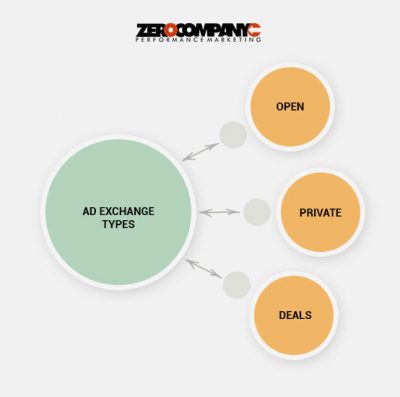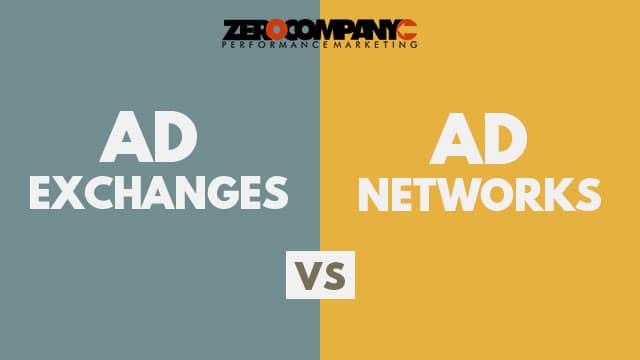What were two of the most exciting innovations impacting the digital space since the start of the 21st century?
No doubt they were the inventions of the ad network and the ad exchange – two game changers for buyers and sellers of digital media. Few would argue that these ideas revolutionized the way brands buy ads online, but they also paved the way for hyper-targeted programmatic advertising.
In this post, we will give you a thorough understanding of the differences between an ad exchange and an ad network, show you how they complement one another, and which one is more often used by digital agencies that specialize in programmatic advertising.
Table of Contents
What is an Ad Exchange?
An ad exchange is often compared to a gigantic shopping mall for digital ad inventory, one where publishers and advertisers find one another and make deals in real time. Sellers, or publishers, put their inventory on the platform and make it available to buyers, and an ad exchange facilitates the transaction through its real-time bidding (RTB) technology.
By serving as the autonomous mechanism through which an auction takes place, the ad exchange maintains a neutral position, serving neither the seller nor the buyer. It is this process, fueled by technology, which enables the sale of display, video, mobile, native, and in-app inventory, based on the buyer’s desired audience.

What is an SSP (Supply-Side Platform)?
When owners of websites, including major media, blogs, and social sites (also known as “publishers”) are looking to sell their available ad space, they use a supply-side platform, or SSP to find buyers. Often called the “very best friend of a digital publisher”, the SSP makes it possible for these publishers to monetize their websites.
What is a DSP (Demand-Side Platform)?
What are the Three Types of Ad Exchanges?
Open Ad Exchange
Think of this as your public marketplace with extensive digital inventory from multiple publishers. All buyers are able to bid on the inventory here, but it is especially attractive to buyers seeking a broader audience. On an average day, 70 billion ad impressions flow through open ad exchanges, which makes it difficult to detect and prevent ad fraud. As a result, the transparency and safety offered in a private marketplace ad exchange is often preferred.
Private Ad Exchange
Often called a PMP, or private marketplace platform, this type of ad exchange allows publishers more control over the sale of available inventory. Rather than being open to the public, each private exchange is operated by a publisher who invites specific buyers to its platform. A private ad exchange may also grant permission to certain agencies or advertisers, but it can just as easily block third parties from granting access to its ad impressions. Because it requires negotiation with individuals, private marketplace deals may be more time-consuming for buyers when compared with an open ad exchange.
Preferred Deals
Less popular than open and private ad exchanges, a preferred deal allows publishers to sell available impressions at a preset price for preferred advertising clients. Not only does this provide a steady revenue stream for publishers, but advertisers also benefit from guaranteed rates and preferred access to premium inventory.

How Do Ad Exchanges Benefit Both Advertisers and Publishers?
Like a match made in heaven, programmatic ad buying is the perfect marriage between available ad space and interested advertisers.
Because unsold impressions would otherwise be wasted, the on-demand pricing model available on ad exchanges gives advertisers a unique opportunity to efficiently connect with potential customers.
Publishers also benefit from being able to monetize a much higher percentage of their ad space, along with the ability to control pricing and block ads with sensitive content.
Control mechanisms for publishers include: | Customizable options for advertisers include: |
|---|---|
Setting a minimum price, or CPM for ad units
| Budget setting, bidding, and pacing options |
Blocking and filtering ads with potentially objectionable content, as well as from specific advertisers | Select desired target audience and behavioral profiling |
Selecting the types of ad formats and sizes that will be accepted on the platform | Ability to blacklist specific websites and/or audiences
|
Retargeting options across numerous exchanges and ad frequency caps |
What Are Ad Networks and How Do They Differ from Ad Exchanges?
Often confused for an ad exchange, an ad network seems to perform a similar role, but in reality, they are totally different concepts. An ad network collects inventory from various publisher sites or purchases ad impressions or may even buy them in bulk from ad exchanges and then repackage them to create a new programmatic tactic.
By saving advertisers the time it takes to filter through available inventory, an ad network aims to create high quality options focused on specific demographics, pricing models, geography, and online behaviors.
To help illustrate the differences between an ad exchange and an ad network, think of an exchange as an open pool of impressions, and an ad network as a privately-traded suite of digital tactics. Many agencies prefer an ad exchange because of its pricing transparency. In comparison, an ad network may inflate prices for more desirable inventory.

Which Ad Networks Are Most Popular?
Some of the top ad networks include Google AdSense, the Facebook Audience Network, and Apple Advertising, but there are countless other networks for every possible type of advertiser, each with its unique selling points.
Whether it’s the size and versatility of Google’s AdSense ad network or the extensive cache of audience data available through Facebook, a programmatic campaign can mix and match the various networks to meet every campaign objective.
Which Method is used in Programmatic Advertising?
The decision of ad exchange or ad network will depend on your comfort level with real time bidding on an open exchange. You are certainly able to reach your target audience with either. Say for a Financial Services company like an asset manager who is interested in reaching accredited investors, financial professionals or high-net-worth individuals (HNWI) interested in ETFs and green investing who use the Robinhood app, you can reach them in either advertising marketplace. Each comes at a cost. Early on, a less experienced buyer might opt for an ad network that offers exclusive access to premium inventory, but in the world of programmatic buying, that assurance comes at a price. The more efficient way to buy display ads online is through real-time bidding against a set of parameters that will deliver a similar audience, often at a fraction of the price.
Sitting at a trading desk on an ad exchange would be a bit intimidating for any untrained marketer, but do not let that stop you from real-time bidding. An easier way to optimize display campaigns is to work with a digital marketing agency.







